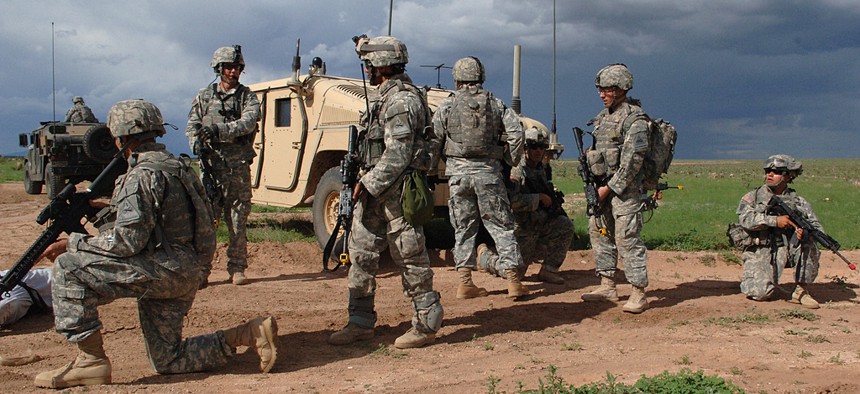Shutdown Delays (but Fails to Cancel) Army Network Exercise

Soldiers move during an exercise at Fort Bliss in 2008. Defense Department file photo
Ft. Bliss test slated to run Nov. 4-17.
The Army will go ahead with its semi-annual Network Integration Exercise at Ft. Bliss, Texas, in early November, if the shutdown ends this week as expected, multiple Army sources told Nextgov.
The Army originally planned to kick off the NIE on Oct. 28, but the shutdown pushed the start of the exercise to Nov. 4, Army sources who declined to be identified said. The exercise is scheduled to go through Nov. 17.
Lack of funds will probably delay a communications exercise slated to start Thursday by the 2nd Brigade, 1st Armored Division, to fine tune systems under evaluation, the sources added.
The Army plans to use the Ft. Bliss soldiers to test upgraded troop tracking and command post systems and a broadband, manpack radio system, NIE sources told Nextgov.
The NIE will evaluate hardware and software of the Command Post of the Future developed by General Dynamics C4 Systems. The project combines feeds from different mission command systems so all the data is live and shared in real-time. It is referred to as ‘WYSIWIS,’ or ‘what-you-see-is-what-I-see.’
The NIE will also test the next-generation architecture for the Command Post of the Future, which enables entire theaters of operation to collaborate on a single distributed data repository with thousands of users.
The Army will also test its Joint Battle Command-Platform, an upgrade of its Force XXI Battle Command Brigade and Below/Blue Force Tracking, or FBCB2/BFT, first fielded in Bosnia in 1998 to automatically track friendly and enemy forces.
Upgrades to the Joint Battle Command-Platform under test at the NIE will include a new user interface with features such as touch-to-zoom maps and drag-and-drop icons, secure data encryption, a faster satellite network, and interoperability with Marine Corps systems. The Army will use the NIE to conduct an operational assessment of the system to assure reliable connectivity with its secure in-line data encryption.
The Army will also conduct follow-up test and evaluation activities to assess and demonstrate the capabilities of the Harris AN/PRC -117G manpack radio, which originally fielded to units in Afghanistan in 2009, with more than 3,000 radios fielded since then.
The AN/PRC-117G is not a formal program of record, and the Army is testing it during the NIE at the request of Office of the Secretary of Defense. User feedback at the NIE will help the Army develop future tactical network modernization plans.
The Army plans acquire 60,000 commercially developed manpack radios that run government-owned software waveforms, along with vehicle and handehled radios, at a cost pegged at $700 million.



